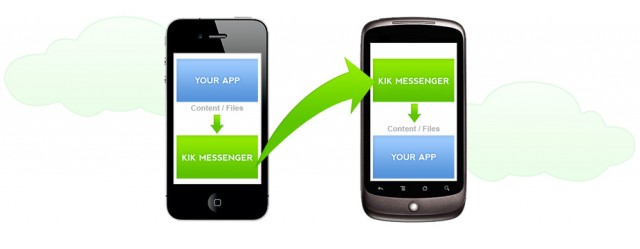
Kik introduced an API recently that allows third-party developers to plug into the existing infrastructure of the burgeoning messaging company. With apps like Sketchee, mobile users can draw on a blank canvas and share their creations over Kik’s instant network; if the other user has the app installed they can add to it and send it back. The concept may sound simple — and at the moment, there are only a few other equally-simple apps to choose from — it has huge potential to change the way we communicate. Full Kik API integration was recently brought to both the Android and iOS apps, with other platforms coming soon.
At its core, the Kik API brings IM capabilities to third-party apps: say you have an existing app, for example a Fantasy Football integrator. But setting up your team is a lonely prospect if there’s no one to talk to, so the developer, instead of building his own platform, hooks into Kik’s API and allows users with existing Kik accounts to talk to one another from within the app. You don’t have to worry about logging in — if you have the app installed, you’re already authorized — it just shows your contact list and you can start chatting without going anywhere.
But there is more potential here, and I had a chance to speak to Kik evangelist Yuriy Blokhin about the future of the API. “One possible direction for development of the API is the concept of a ‘bot,'” he says. “It simply means a Kik account that can be programmatically controlled and perform various actions upon inbound messages.” Say you’re going to a conference and you want to know where the sign-in table is. You message ‘Kikbot’ in your list, and it generates a semantically-correct automatic response based on your inquiry. ‘Kikbot’ will send understand the words ‘sign-in’ or ‘directory’ and generate a response: “The sign-in table is located near hall B2 on the second floor.”
The exciting part of the Kik API, for me at least, is the prospect of it hooking into existing popular platforms like Foursquare. Say I decide to check in to a concert venue. With the Kik API plugged into my Foursquare account, the app could tell me which of my Kik friends is also at the venue and prompt me to begin a chat session with them. Or, if I am using my favourite Forum app and one of my Kik friends is logged into the same forum as I am, we could instantly move from passive to active communication from within the application.
These are just a few ways in which a strong existing IM platform like Kik can be built into our daily lives, and for that reason I am more excited than ever about its potential. The instant messaging business is thriving, but it’s also quite saturated — there are a lot of competitors, from WhatsApp and BBM to traditional platforms like AIM and GChat — so having a thorough mobile and web API can change the industry for the better.
(Thanks to Yuriy and Bob!)


